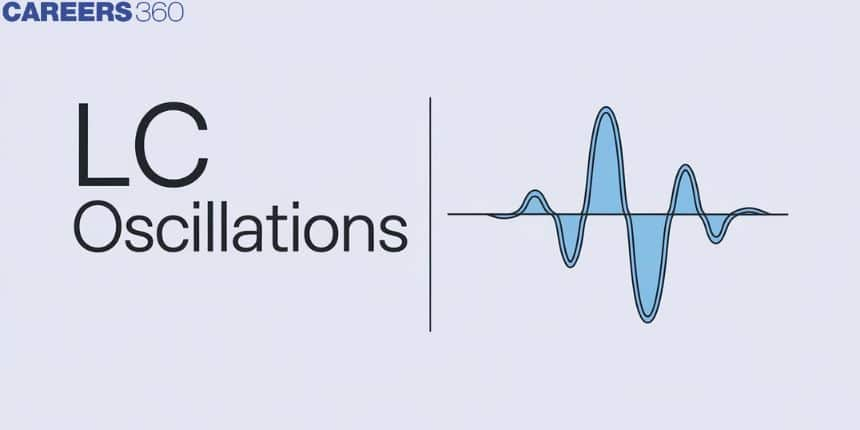LC Oscillations
LC oscillations refer to the periodic exchange of energy between an inductor (L) and a capacitor (C) in an electrical circuit. These oscillations occur due to the capacitor discharging through the inductor and then recharging with the opposite polarity, creating a continuous cycle of energy transfer. This phenomenon is fundamental in the operation of various electronic devices, such as radio transmitters, where LC circuits are used to generate and tune radio frequencies. In real life, LC oscillations are crucial for signal processing, wireless communication, and the functioning of many modern technologies that rely on stable and controllable oscillatory signals. This article explores the principles of LC oscillations and their practical applications in everyday electronics.
New: JEE Main/NEET 2027 - Physics Important Formulas for Class 10
JEE Main 2025: Study Materials | High Scoring Topics | Preparation Guide
JEE Main 2025: Syllabus | Sample Papers | Mock Tests | PYQs | Study Plan 100 Days
NEET 2025: Syllabus | High Scoring Topics | PYQs | Crack NEET in 2 months - Study Plan
- LC Oscillations
- Solved Examples Based on LC Oscillations
- Example 1: In an LC circuit, we have an inductor of L = 20mH and a capacitor of capacitance 50F. Initially charge on the plate of the capacitor is 10 mC. What is the total electric field energy stored in the capacitor in Joule?
- Summary

LC Oscillations
LC oscillations occur in circuits containing both an inductor (L) and a capacitor (C), where energy oscillates between the electric field of the capacitor and the magnetic field of the inductor. When a charged capacitor is allowed to discharge through a non-resistance, electrical oscillations of constant amplitude and frequency are produced. These oscillations are called LC oscillations.
Let a capacitor be charged qm (at t = 0) and connected to an inductor as shown in Fig.
The moment the circuit is completed, the charge on the capacitor starts decreasing, giving rise to the current in the circuit.

Let q and i be the charge and current in the circuit at time t.
Since
According to Kirchhoff’s loop rule,
i = -(dq/dt) in the present case (as q decreases, I increase).
This equation has the form of
a simple harmonic oscillator. The charge, therefore, oscillates with a natural frequency.
And varies sinusoidally with time as:
where qm is the maximum value of q and φ is a phase constant. Since 
The current
where
Since there is no current in the circuit; energy in the inductor is zero. Thus, the total energy of the LC circuit is
Recommended Topic Video
Solved Examples Based on LC Oscillations
Example 1: In an LC circuit, we have an inductor of L = 20mH and a capacitor of capacitance 50F. Initially charge on the plate of the capacitor is 10 mC. What is the total electric field energy stored in the capacitor in Joule?
1) 1
2)2
3)4
4)3
Solution:
Given, charge Q=10 mC=10 x 10-3 C and capacitance C = 50 x 10-6 F. The electric field energy stored in the capacitor is :
Hence, the answer is the option (1).
Example 2: In an oscillating LC circuit the maximum charge on the capacitor is Q. The charge on the capacitor when the energy is stored equally between the electric and magnetic field is:
1)
2)
3)
4)
Solution:
Let Q denote the maximum charge on the capacitor. Let q denote charge when energy is equally shared
Hence, the answer is the option (3).
Example 3: The position vector of the centre of mass
1)
2)
3)
4)
Solution:
Let the mass of the bar with length L=m
so the Figure can be shown as

Similarly
Hence, the answer is the option (4).
Example 4: A fully charged capacitor C with initial charge q0 is connected to a coil of self-inductance L at t = 0. The time at which the energy is stored equally between the electric and the magnetic field is
1)
2)
3)
4)
Solution:
As,
Maximum energy stored in capacitor
Let at an instant t, the energy be stored equally between electric and magnetic field. The energy stored in the electric field at the instant $\mathrm{\mathrm{t} }$ is
Hence, the answer is the option (1).
Example 5: In the circuit shown, the AC source has voltage

1)
2) 3.3 A
3)
4)
Solution:
Total resistance of the circuit
Inductive reactance
Hence, the answer is the option (1).
Summary
LC oscillations involve the periodic exchange of energy between an inductor and a capacitor in an electrical circuit, resulting in harmonic oscillations. These oscillations are fundamental to the functioning of various electronic devices, such as radio transmitters and signal processors, where stable and controllable oscillatory signals are crucial. The energy in an LC circuit oscillates between the electric field of the capacitor and the magnetic field of the inductor, with applications ranging from wireless communication to the development of modern technologies.
Also Read
17 Nov'24 10:07 AM
25 Sep'24 05:30 PM
25 Sep'24 02:55 PM
25 Sep'24 02:53 PM
25 Sep'24 01:31 PM
25 Sep'24 01:30 PM
25 Sep'24 01:29 PM
25 Sep'24 01:27 PM
25 Sep'24 01:26 PM
25 Sep'24 01:25 PM